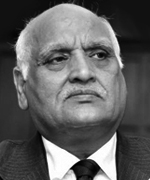From Learning to Unlearning June 2024
 Maj. Gen. Raj Mehta (retd)
Maj. Gen. Raj Mehta (retd)
Recognise that unlearning is the highest form of learning
—Rumi
The potentially climacteric high altitude Kargil War of May–July 1999 between nuclear powers India and Pakistan was fought in alpine Himalayan heights ranging around 5,000 to 5,800 metres above sea level in the Kargil and Batalik sectors of Ladakh. India found itself ill-prepared to fight when the war began, having to make do "with whatever he had” in the no-nonsense words of then Army Chief Gen. VP Malik. The Indian forces underwent the ignominy of both strategic and tactical surprise, clawing back from a prohibitively costly start in human and equipment/aircraft losses to stabilisation and thereafter on to unconditional victory against an implacable enemy, even as the world watched this televised war unfold. The bitter no-holds-barred fighting took place over 85 days as intensive diplomatic activity proceeded worldwide to limit the war from possible escalation to nuclear Armageddon. Eventually, the Pakistani Prime Minister capitulated, with 26 July 1999 being Victory Day for India but at a huge cost. Gen. Malik writes that India employed about two divisions (including about 250 artillery guns) in the Kargil War front and mounted 1,200 fighter and 2,500 helicopter sorties. During the war, 473 Indian soldiers were killed and around 1,500 wounded. Pakistani casualties were estimated to be over 700 killed.
With the silver anniversary of Kargil at hand, there is a rush to espouse what India learned from the Kargil victory; from its start-up valleys of sloth and despond to its later highs of bloody success and, not the least, its ‘lessons’ learnt. George Santayana famously warned us that those who fail to learn the lessons of history are doomed to repeat it. Modern philosopher Aldous Huxley quipped that the most important thing we learn from history is that we never learn from it. These are smart, pithy aphorisms but what do we really know about how to learn from history and how not to?
One attitude toward learning from history is that one does it as aesthetics, not as a means to more practical ends. AJP Taylor, a prominent 20th century historian believed that writing history is “an art like painting or architecture and designed similarly to only give intellectual and artistic pleasure.” This highlights not just the subjectivity of history but also how difficult it is to learn ‘lessons’ from it. If executed, this would involve two processes: first, the inductive process of sifting historical evidence to access general truths about what happened, followed by a deductive process of applying these truths to the present, maybe even to the future. Such examination however leaves out the enemy; its motivations, its capabilities then and now and how this impacts our learning.

Gen. V.P. Malik with troops during the conflict. This photograph is from his book Kargil: From Surprise to Victory
This is thus a slip-shod, linear approach. Cognitive psychology suggests that in a given context, we only see what we expect to see and ignore what we don’t expect to see. Robert Jervis says in his iconic book Perception and Misperception in International Politics that the credo followed is: ‘I’ll see it when I believe it”. This suggests two realities: A roughshod seat-of-the-pants reasoning by analogy which is how we’ve learned lessons thus far. There’s another, more analytical system: Separating facts from fiction, evaluating information objectively, establishing context and only then drawing lessons. It involves forgetting mindsets and deliberate blockages of cognition. It involves unlearning. The stunning depth in the quote by Rumi, the 13th century Persian Sufi scholar/poet presciently suggests that all learning emerges from unlearning. Unlearning is a reminder that the only verification of reality is experience. Unlearning is experience, moving from “knowing everything” to experiencing step-by-step new learning. Though M
Subscribe To Force
Fuel Fearless Journalism with Your Yearly Subscription
SUBSCRIBE NOW
We don’t tell you how to do your job…
But we put the environment in which you do your job in perspective, so that when you step out you do so with the complete picture.







